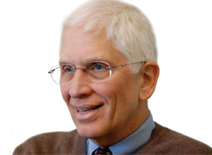Creating a "Neural Network" of Clinical Care
Doug Jones on Making Improvements in a Complex System
 (May 2, 2011) How do you take something very good—clinical care on the Anschutz Medical Campus—and make it even better? That’s what Doug Jones, MD, was asked to figure out. The medical school’s dean, Richard Krugman, MD, last year named Jones senior associate dean for clinical affairs. Part of his job is to find ways to promote what Krugman calls "clinical transformation" on a campus that includes the medical school, University of Colorado Hospital, The Children’s Hospital and University Physicians, Inc. Jones, a former chair of the Department of Pediatrics, spoke about the effort.
(May 2, 2011) How do you take something very good—clinical care on the Anschutz Medical Campus—and make it even better? That’s what Doug Jones, MD, was asked to figure out. The medical school’s dean, Richard Krugman, MD, last year named Jones senior associate dean for clinical affairs. Part of his job is to find ways to promote what Krugman calls "clinical transformation" on a campus that includes the medical school, University of Colorado Hospital, The Children’s Hospital and University Physicians, Inc. Jones, a former chair of the Department of Pediatrics, spoke about the effort.
Question: What are your goals?
Answer: The most important thing is to have effective ways of coordinating our decision-making and following
Q: What else beyond the neural network?
A: We need to ensure that clinical excellence continues to be recognized and rewarded within the School of Medicine. We also need to make sure we have in place resources for faculty development in the scientific disciplines that relate to patient safety, quality improvement
Q: What about data systems? How important is
A: Very important. We need to make sure we have the systems and, just as important, the capacity for data analysis to keep track of what we do in clinical care. But I have to say, as important as technology is, we have data now that we don’t use because we lack the analysts to bring it together and present it in ways that people can respond to it.
Q: You said this is a complex environment. How do you get everyone on board and moving forward?
A: Complex organizations don’t respond well to micro-managing. It just doesn’t work. We need to have simple principles we agree to, and then
I’m confident the faculty, with typical energy, creativity, skill
Q: What other barriers do you see?
A: We serve an especially complex group of patients. Part of the complexity is due to the broad range of medical conditions that come to an academic medical center, from straightforward to the most complicated. Another element is the fact that we care for patients from all parts of the socioeconomic spectrum. Nonmedical social circumstances have important implications for medical care. It’s harder than one might think to set up one system that serves all these patients equally well. Also, as many others have pointed out, with fee-for-service reimbursement, care tends to be fragmented. Coordination is not paid for. It depends on goodwill. It doesn’t arise spontaneously out of the reimbursement system.
Q: Obviously, the hospitals, medical school
A: It only would be a problem if leaders of each of these institutions weren’t committed to making this work. Leadership at the School of Medicine is especially important. With Dick Krugman as dean for 20 years, we have the best possible situation.
Q: The public might find this exercise odd. You’re leading an effort that’s striving for excellence, but a patient might say, "What, you aren’t always doing that anyway?"
A: We have superb individual physicians and other professionals and outstanding programs, but we are not as consistent or as coordinated as we might be. We can’t ask people to work harder or be more devoted to patients. They’re doing that. We need to build a more effective system that delivers the safest and best care for the least amount of money. We have to show that we can do this every day.
Q: I’m trying to find a phrase to describe this. Is this a cultural shift?
A: We need to resist the temptation to think in terms of my department, my center, my hospital. All of the health professionals and institutions on the Anschutz Medical Campus need to work closely and collaboratively with only one thing in mind: the welfare of the patient.
Q: Are there examples you’d point to now?
A: A recent example of inter-hospital and inter-professional collaboration is the maternal-fetal program at Children’s and University